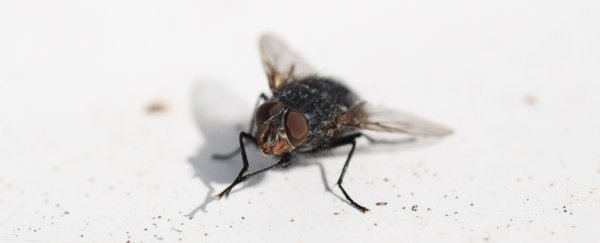They get into your trash, they swarm to sewage and corpses, they spew on everything, they're covered in bacteria and germs from the (literal) crap they like to land on, and then they walk their grubby little feet all over your food. Flies are super gross.
But they may be even worse than that. They may, according to new research, be carrying all manner of pathogens, and spreading them around on their mucky little bodies - more specifically, their mucky little legs.
The insects' role in the spread of pathogens and infectious diseases is fairly well known - it's not for nothing that they have been referred to as "germs with legs." Yet it was barely 50 years ago that the evidence for it was "inconclusive."
Now, researchers from Penn State's Eberly College of Science have led a study that adds to a growing body of evidence. By examining the microbes that flies carry on different parts of their bodies, the study provides some insight into the extent of the extreme filth of flies.
They studied the microbiomes of 116 houseflies and blowflies from three different continents, and what they found was really squalid. Some flies were carrying hundreds of different species of bacteria, many of which are harmful to humans, transmitting them to surfaces they land on - mainly via their legs.
"The legs and wings show the highest microbial diversity in the fly body, suggesting that bacteria use the flies as airborne shuttles," said Stephan Schuster, former professor of biochemistry and molecular biology at Penn State.
"It may be that bacteria survive their journey, growing and spreading on a new surface. In fact, the study shows that each step of hundreds that a fly has taken leaves behind a microbial colony track, if the new surface supports bacterial growth."
The researchers found more pathogens on flies collected from human-heavy urban environments than those found in stables. They also found 15 instances of a human pathogen called Helicobacter pylori, which causes gut ulcers, mostly in flies collected in Brazil.
Most likely, the flies collected the bacteria from open sewage or latrines, the researchers noted.
These findings suggest that flies carry more pathogens when they are around more people.
"We believe that this may show a mechanism for pathogen transmission that has been overlooked by public health officials, and flies may contribute to the rapid transmission of pathogens in outbreak situations," said Penn State biochemist Donald Bryant.
"It will really make you think twice about eating that potato salad that's been sitting out at your next picnic. It might be better to have that picnic in the woods, far away from urban environments, not a central park."
While this information may increase your aversion to flies, there may be ways scientists can leverage the insects' bacteria-teeming bodies.
Sampling fly microbiomes, for example, could help study the microbial content of environments that are otherwise hard to reach.
Is that a good trade-off? Hard to say, but there has to be some sort of silver lining to the flying filth thimbles.
The research has been published in the journal Scientific Reports.
